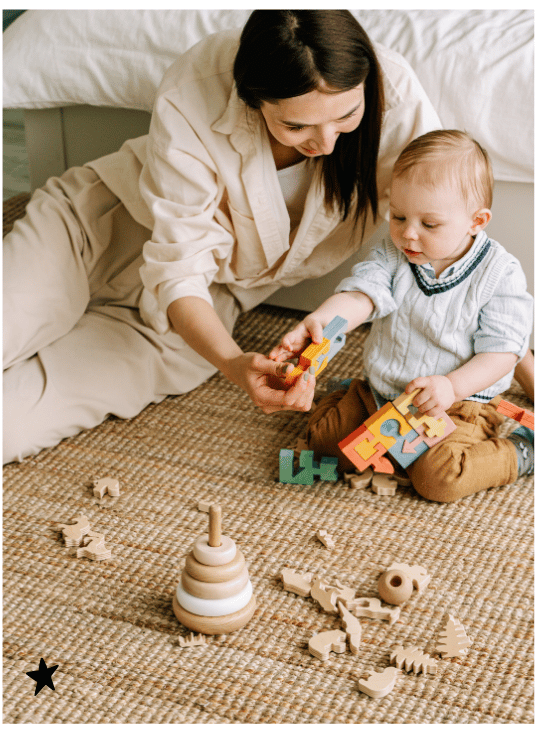Too Many Toys or Fewer Toys?
11/13/20249 min read


Too Many Toys or Fewer Toys?
In a world overflowing with choices, parents often wonder if more toys bring more happiness. But what if fewer toys actually lead to greater joy? When children have too many options, their attention scatters, and the value of each toy diminishes.
With fewer toys, kids engage more deeply, using creativity and focus to invent new ways to play. A simple set of blocks can become castles, bridges, or anything their imagination creates. They learn patience, resourcefulness, and gratitude for what they have.
Fewer toys also foster stronger parent-child connections. Playtime becomes more interactive, allowing parents to bond and share in their child’s discoveries.
Simplicity teaches kids that happiness isn’t in abundance but in cherishing what they have. By curating a mindful toy collection, we nurture their imagination, focus, and joy for the present moment.
Too Many Stories or Fewer Stories?
Stories are a powerful way to enrich a child’s world, but the pace of storytelling matters. Overloading with too many stories at once can dilute their meaning, making it harder for children to connect and remember the lessons within.
Pacing stories thoughtfully gives children time to absorb, reflect, and relate. Engage them during storytime by asking questions and exploring characters together. Encourage them to imagine, guess, and think critically about the story’s messages, fostering curiosity and deeper understanding.
When stories are savored, they leave a lasting impact. They become inner treasures that shape values, spark imagination, and nurture empathy, offering lessons children can carry throughout their lives.
Too Many Friends or a Few Deep Connections?
Friendships are essential in childhood, teaching lessons of sharing, empathy, and trust. While having many friends exposes children to diverse personalities and ideas, deeper connections provide the foundation for trust, loyalty, and lifelong support.
Think of a garden: when plants are too crowded, they struggle to thrive. Similarly, a few close friendships allow children to grow emotionally, building bonds that are nurturing and enduring.
Encouraging children to balance meaningful friendships with broader social connections helps them appreciate diversity while cherishing the beauty of being truly understood and supported. This balance fosters both confidence and lasting relationships.
Too Much Instruction or Encouraging Self-Decision?
Guiding children is a natural parental instinct, but over-instructing can unintentionally hinder their ability to think independently and trust their instincts. Imagine a bird in a cage—it’s safe but unable to soar. Similarly, children need space to spread their wings and make decisions, learning from both successes and mistakes.
Encouraging self-decision builds confidence, responsibility, and problem-solving skills. While parents should provide guidance, allowing children to choose their clothes, plan their day, or make small decisions empowers them. Striking a balance between instruction and independence nurtures self-worth and prepares them to navigate life confidently.
Too Many Social Interactions or Allowing Them to Get Bored?
In a world full of playdates and activities, it’s easy to overlook the value of boredom. While social interactions teach teamwork and empathy, constant engagement can leave little room for creativity and self-discovery.
Allowing a child to sit with boredom encourages them to explore their imagination and find joy within. It nurtures resilience and independence, teaching them to create their own fun rather than relying on external stimulation.
Striking a balance between social time and quiet moments helps children appreciate both connection and solitude. In that stillness, they unlock curiosity, creativity, and a deeper sense of self.
Too Much Praise or Constructive Encouragement
Praise is a beautiful way to express love, but too much of it—or focusing only on results—can lead children to seek constant validation. Over time, they may tie their self-worth to external approval or fear failure.
Constructive encouragement shifts the focus to effort, growth, and learning. Saying, “You worked really hard on this!” instead of “You’re the best!” helps children value perseverance and progress. It builds resilience, confidence, and pride in their journey, not just outcomes.
Balancing praise with thoughtful encouragement nurtures a child’s inner compass, fostering self-motivation and a love for learning and growing.
Too Much Academic Pressure or Room for Curiosity?
Focusing solely on grades and performance can strip learning of its joy, turning it into a chore rather than a passion. Too much pressure often stifles a child’s natural curiosity, making them study for approval instead of discovery.
Giving space for curiosity allows children to explore the world at their own pace, ask questions, and find joy in learning. When balanced with academic goals, it fosters both achievement and a lifelong love of knowledge.
Encourage curiosity-driven activities—nature walks, creative projects, or books of their choosing—to help them see learning as a journey, not just a race to the top.
Too Many Rituals or Time for Silent Worship?
Rituals offer a sense of tradition and belonging, weaving stories of culture and faith into a child’s life. However, too many or overly elaborate rituals can sometimes feel like tasks rather than meaningful experiences, making spirituality seem distant or rigid.
Silent worship, in contrast, invites a child to connect inwardly, offering moments of peace and personal reflection. It encourages them to feel gratitude and presence in their own way, beyond the framework of rituals.
Balancing the two—simple rituals with moments of quiet reflection—helps children see spirituality as both a shared tradition and a deeply personal journey.
Too Much Attention When the Child Is Sick or a Balanced Approach?
When children are sick, they naturally seek comfort and care, and as parents, it’s instinctive to shower them with attention. While this care is vital, too much focus on their illness can unintentionally teach them to associate being unwell with receiving extra love and connection.
A balanced approach fosters emotional resilience. Comfort them with steady, calm care while gently reinforcing that sickness is a normal part of life. Encourage positivity by saying things like, “You’re resting now, and your body is working hard to get better.”
This balance helps them feel supported without amplifying their discomfort, teaching them self-soothing and resilience as they grow.
Too Much Screen Time or Tech-Free Play?
In today’s digital age, it’s easy for children to spend hours immersed in screens, whether it’s through games, shows, or social media. While technology has its benefits, excessive screen time can limit opportunities for creativity, social interaction, and exploration of the real world.
Hands-on, tech-free play encourages children to use their imaginations, develop problem-solving skills, and build emotional intelligence. These activities, like playing outside, crafting, or reading, allow children to engage with the world in meaningful ways.
However, technology is a vital part of modern life, and children need to learn how to use it wisely for both education and future success. The key is finding a balance:
Set Screen-Time Boundaries: Designate specific times for screens while ensuring plenty of tech-free time for other activities.
Make Tech-Time Purposeful: Use technology for educational purposes, like coding apps or creative projects.
Foster Tech-Free Habits: Create screen-free zones for family time or relaxation.
Model Balanced Behavior: Demonstrate balanced screen use yourself to set a positive example.
Integrate Tech-Free Play: Encourage hands-on activities that stimulate creativity and social skills.
By balancing screen time with tech-free activities, children can thrive in both the digital and real worlds, developing skills that support their holistic growth.
Helicopter Parenting or Hands-Off Parenting?
Imagine teaching your child to ride a bike. As they wobble, you instinctively want to hold on and protect them from falling. But a voice inside reminds you to let go, to trust them to learn on their own. Parenting often finds itself between two extremes: helicopter parenting and hands-off parenting. Each approach has its strengths and weaknesses, but balance is the key to raising confident, resilient children.
Helicopter Parenting: The Overprotective Embrace
Helicopter parents hover over every aspect of their child’s life. They want to shield them from failure, disappointment, and pain. While this can create a sense of safety and security, it can also prevent children from developing independence, resilience, and problem-solving skills.
Upside: Children feel deeply supported and often achieve academic and social success.
Downside: Over-protection can lead to dependence, anxiety, and a lack of confidence in their abilities.
Hands-Off Parenting: Trusting Them to Soar
Hands-off parents trust their children to navigate the world on their own. They encourage independence and allow their kids to make mistakes, take risks, and solve problems without interference. While this fosters self-reliance, it can sometimes feel neglectful or leave children unprepared for challenges they aren’t ready to face.
Upside: Children grow up confident, resilient, and capable of handling setbacks.
Downside: Lack of guidance might lead to feelings of being unsupported or lost in difficult situations.
A Heartfelt Middle Ground: Love with Trust
The best approach lies somewhere in the middle. Children need both protection and freedom—the love of a parent who supports them and the trust to allow them to grow on their own.
Be There, But Step Back: Provide a safety net without hovering. Let them try and fail, knowing you’ll be there if they fall too hard.
Empower Decision-Making: Encourage them to make decisions, offering guidance but allowing them to take the lead.
Foster Resilience: Let them experience the natural consequences of their actions, teaching responsibility and resilience.
Parenting Is Like Flying a Kite
Think of parenting as flying a kite. At first, you hold the string tightly, ensuring the kite stays aloft. But as the wind picks up, you loosen your grip, allowing the kite to soar higher. You guide it gently, but you don’t control it. Like the kite, your child needs both your steady hand and the freedom to fly.
The Legacy You Leave
Parenting isn’t about hovering or stepping away entirely. It’s about preparing your child to thrive independently while always knowing they are loved and supported. When the time comes for them to soar, they’ll carry your love and trust with them as they navigate life’s winds.
In the end, the art of parenting is about finding the balance between holding on and letting go, allowing your child to grow into the person they are meant to be.
Too Many Rules or Flexible Boundaries?
Imagine a child in a home filled with constant rules. They might feel as though they are walking a tightrope, constantly trying to avoid mistakes and meet expectations. Too many “don’ts” and “musts” can create an environment of stress and compliance rather than exploration and growth. It’s exhausting for both the child and the parent.
On the flip side, a home with no rules or boundaries can feel like floating aimlessly in an open sea. While it may seem freeing, a lack of direction and structure can leave a child feeling lost or unsure of what is expected of them. The absence of clear boundaries might create anxiety, not freedom.
A Different Way
Rather than imposing countless rules, focus on creating meaningful ones that align with the values you want to instill in your child. Rules that emphasize kindness, respect, and safety will have a much greater impact than a long list of regulations.
For example, instead of saying, "You can't go out," say, "I’d like you to be home by dinner so we can spend time together." This shift moves the focus from control to connection, creating a space where your child can feel both safe and valued.
Freedom Within Limits
Children thrive when they have room to explore, experiment, and make decisions, but within a framework of trust and consistency. Think of it like drawing a circle of safety around them. Inside the circle, they can test their limits, take risks, and learn from mistakes. Outside that circle are the boundaries—clear, firm, and consistent—that offer the structure they need to grow.
Listening to Your Child
Sometimes, instead of enforcing strict rules, try listening to your child’s perspective. For example, if they are struggling with homework, don’t simply say, “You must finish it now.” Instead, ask, “What’s making it hard for you to concentrate? How can I help?” Involving your child in the decision-making process teaches them responsibility and shows that you value their input. It helps them appreciate your guidance instead of resenting it.


























